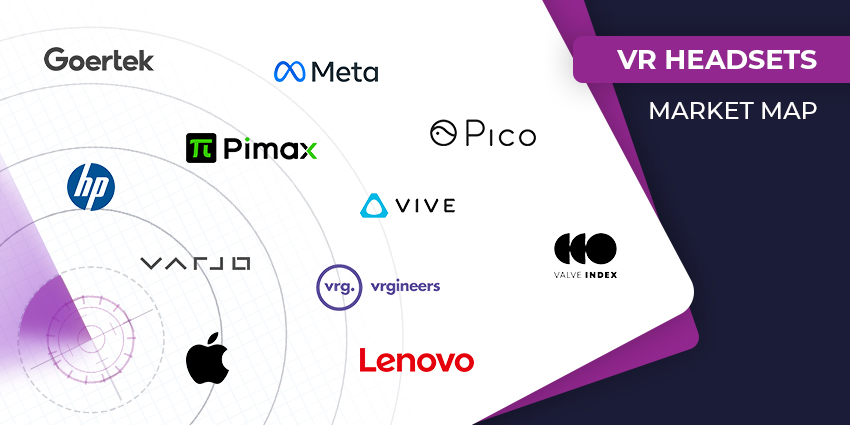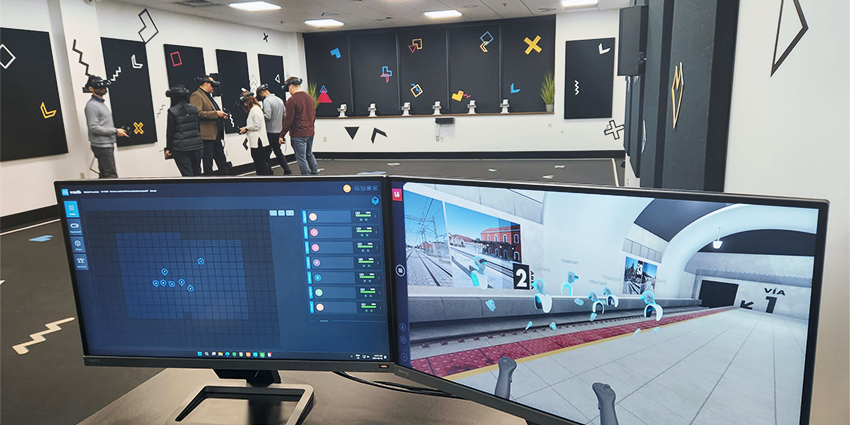Virtual reality (VR) solutions for business end users provide workplaces with tools like headsets, motion capturing (mocap), and a host of services to improve enterprise communication, training, and collaboration.
Several firms have begun leveraging immersive technologies across numerous verticals, including field service, education and training, healthcare, and the architectural, engineering, and construction (AEC) industry.
Additionally, VR equipment has begun upgrading with emerging technologies such as hand and eye-tracking, passthrough, analytics monitoring, and human-computer interfacing (HCI).
Amid the enhancements, VR business headset manufacturers have also introduced and backed enterprise-level hardware to help organisations, companies, and institutions advance.
Here are some of the top headsets creating the broader business XR ecosystem.
Lenovo ThinkReality VRX
Lenovo’s latest creation, the ThinkReality VRX, debuted at the Immerse Global Summit in Madeira, Portugal last year. News of the next-generation device provided a glimpse into the future of the enterprise metaverse — an interconnected system of XR products, services, and solutions for businesses.
The headset offers companies unrivalled performance, support, and interoperability due to its laser focus on the enterprise rather than combining business and consumer markets like competitors.
Lenovo’s ongoing partnership with Qualcomm, a world first for an XR device starting with its A3 smart glasses, leverages the exemplary Snapdragon XR2+ on the VRX.
It also includes top specifications such as 12 GB RAM, 128 GB storage, 2280 x 2280 pixels per eye, a 95° Field Of Vision (FoV) with 70/90Hz refresh rates, pancake optics, and 6 degrees of freedom (DoF)
Jason McGuigan, Head of Commercial Virtual Reality (VR) for Lenovo, explained the impetus for the VRX to XR Today on the sidelines of the event,
“When we looked at this, we recognised we have to be top of the line with most of these things if we’re going to [offer clients] an expandable, versatile use. We have to really hit all those high marks and I believe we’ve achieved that”
He added that the full stack of Lenovo hardware and ThinkReality mobile device management (MDM) provided benefits such as remote device monitoring, management, and licencing.
Additionally, Lenovo’s ThinkReality VRX offers massive levels of interoperability on the ThinkReality platform. This provides users with a device-agnostic toolkit for uploading bespoke independent software vendor (ISV) solutions, applications programme interfaces (APIs), simulations, and security.
This allows for the development of a truly open metaverse ecosystem for enterprise and industrial XR users, using the company’s stellar security, service, and software offerings. This has facilitate partnerships with top firms such as ENGAGE XR, Talespin, Micron Technologies, Baker-Hughes, and many others.
Meta Quest Pro
Metaverse giant Meta Platforms has entered the immersive industry with an enterprise-focused headset for educators and businesses — the Meta Quest Pro.
Meta hopes to enhance business outcomes and returns on investment (ROI) by integrating immersive technologies improved hand and eye-tracking and full-colour passthrough.
Retailing at £1,499, the Quest Pro also contains innovations like a Snapdragon XR2+ processor, pancake optics, hand, face, and eye-tracking.
The VR business headset aims to attract small and medium enterprises (SMEs) as well as larger corporations seeking a hardware platform to integrate tailored applications, software development kits (SDKs), and creative content.
Additionally, Meta has entered talks with Chinese tech behemoth Tencent to further expand abroad to mainland markets. Exploring this could allow Meta to collaborate with the world’s largest gamemaker and sell its headsets across China’s massive consumer market.
The news comes as Meta UK’s Future of Work division conducted research in December last year revealing that 81 percent of those surveyed want to work in immersive collaborative settings.
Conversely, the report asserts that only 16 percent of respondents believe video calls facilitate a sense of presence in meetings. Moreover, only 14 percent of people thought video conferencing made it easier to work with colleagues.
HTC VIVE XR Elite
At CES 2023, HTC VIVE introduced an exciting innovation: the VIVE XR Elite, an MR headset to rival the Quest Pro and Pico 4 Enterprise.
The VR business headset debuted this month for £1,299 via a pre-order service. HTC designed the XR Elite device as a modular solution which allows the wearer to customise aspects of the headset to suit certain use cases and environments.
It also features device specification such as a Snapdragon XR2 processor, 128 GB of storage, 12 GB of RAM, a 90 Hz refresh rate, and WiFi and Bluetooth connectivity, among others.
Its modular design mirrors many industrial-grade headsets from firms such as RealWear that leverage a modular design to suit various client requirements.
HTC’s upcoming device also allows users to tether headsets to gaming PCs and laptos for increased computing power, or operate as a standalone product for full mobility.
Pico 4 Enterprise Headset
Last year Pico introduced a new enterprise-grade MR device at the Augmented World Expo (AWE) 2022, creating a significant competitor to Meta’s Quest Pro headset.
The Pico 4 Enterprise Edition offers users similar features as those seen in the Meta Quest Pro, including top-spec Snapdragon XR2 processors, face and hand-tracking, and full-colour passthrough — at a fraction of the price.
It also boasts a new metaverse service to facilitate social media and workplace gatherings online. Pico’s parent firm, ByteDance, also includes an Enterprise Operating System for business users. It sports a simple interface where users can customise immersive experiences and develop bespoke digital content.
Pico Interactive also plans to introduce a Pico Business Store allowing users to access collaboration and training tools for their enterprise needs.
In an interview on the sidelines of the IGS 2022 Europe, XR Today’s David Dungay spoke to Oliver Wöhler, Enterprise Lead for PicoXR EMEA at ByteDance, about the latest solution.
The executive explained that the Pico 4 Enterprise separated its enterprise headset requirements from its’ consumer devices. The former uses a “pure enterprise software on the headset,” providing developer access to professional software professional needs and allowing them to “easily” develop use cases for the headset.
Valve Deckard
Valve debuted the Index VR headset in 2019 alongside the flagship and blockbuster game Half-Life: Alyx. The device revolutionise consumer markets following its launch, thanks to its mobility and impressive controllers.
The accompanying SteamVR hardware and software management suite allows users to connect third-party VR headsets to play Valve-released titles, from immersive gaming to collaboration services.
On the other hand, Valve has begun working on a follow-up headset, to reposition the gaming firm in global XR markets, namely after Meta began leading markets in recent years.
Codenamed ‘Deckard,’ the device may contain amenities such as photorealistic environments, standalone functionality as well as tethering capabilities, and MR full-colour passthrough, among others, reports show.
Companies such as Oberon Technologies debuted their immersive training application on the Valve Index along with a Meta Quest 2 version. In a recent product demo at the IGS 2022 Miami, the company showcased the high specifications of the device compared to the Meta Quest 2. This revealed its tethered functionality, high-spec graphics, and processing capabilities compared to standalone devices.
Varjo XR-3 Focal Edition
Lastly, XR hardware and software firm Varjo has begun building a portfolio of immersive devices. One of its latest devices, the Varjo XR-3, upgraded with a Focal Edition that offers Ultraleap eye and hand-tracking, LiDAR technology, active cooling, enhanced security features, and others.
The new VR business headset provides users with a trove of updates like enhanced, photorealistic visuals for training simulations.
Varjo’s product lineup has remained at the forefront of simulation training. The European Aviation Safety Agency (EASA) has certified the Varjo Aero as an official training tool. Pilots using Varjo’s immersive kit can train using Microsoft Flight Simulator for real-world credit hours for their pilot licences.
Additionally, the cutting-edge headsets led to a massive partnership with BMW for an unparalleled mixed reality experience. Using Varjo XR-3s, BMW hosted a M2 Coupe racing showcase with the headset’s full-colour passthrough, allowing testers to merge the physical and digital worlds like never before.
Moreover, the XR-3 business headset includes full Trade Agreements Act and Buy American Act (TAA-BAA) compliance for deployments with specialist requirements in specific industries.
Which enterprise headsets do you think should make the list? Leave your feedback on our Twitter and LinkedIn social media channels!







